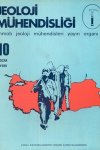
View as PDF
ABSTRACT: The basement rocks of the Menderes massif, often referred to as `the core` consist mainly of augen-gneiss, granitic geniss and migmatites. An obscured unconformity exist between the core- and the overlying cover consisting of two sequences.., The first, metamorphic sequence at the base consist of garnetif erous-schist, muscovite^quartzite, chlorite- chloritoid schist, calc-schist and phllite. Another obscured, unconformity seperates this sequences from the overlying slightly metamorphic sequence which starts with basal quartzconglomerates grading upward to phylliles, dolomite, crystalline limestone, red limestone, turbiditic sandstone and greywackes with exotic blocks. The age of 4Jie cover rocks ranges from Devonian to Paleocene. The rock unite Possibly belonging to the Taurus orogenic belt are correlated with the cover rocks of the Menderes massif and their lateral, continuation is defended, The rocks consisting
ABSTRACT: This article aims to discuss and criticise questions evolving from the age of emplacement and, processes through which ophiolitie melanges are formed. The following points seem, relevant in respect to existing controversies. 1. The nature of the process of melange formation, has not yet `been clearly understood. Sedimentary roeks-that have been deposited after` the emplacement of ophiolites` may have been tectonized resulting in block formation. Thus ages obtained from blocks will indicate .an earlier age of emplacement of`"ophiolites. *` 2. Ophiolites cannot yield pebbles to the shallow shelf deposits during the process of obduction. Thus detritics containing ophiolitie pebbles must be underlain (or be adjacent to ophiolitie outcrops on the continent side) by ophiolitie rocks. 3. The term. "Ophiolitie melange" is used as a genetic term despite its undoubtable descriptive nature, Melanges may not necessarily consist of roks belonging to the same tectonic environment. An ophillitie melange may contain volcanic rocks of continental. . characte as- well as sedimentary rocks deposited after the emplacement. Mapping of such tectonic units result in fatal mistakes in interpretations leading to geotectonic models. 4, `Working `hypotheses particularly the closure of a Mesosoic oceahic crust during late Cretaceous results in unnoticing critical and important contradictions., It may be concluded that ophiolite emplacement is Pre^Mesosoic in age and possibly much earlier.
ABSTRACT: Başlamış formation cropping` out in the vicinity of Başlamış- village,, west of Menderes massive, overlies the ophiolitic complex with. an. angular uneonformity.- It consist, from base to top, of a conglomerate consisting mainly of opMolite pebbeles and is transitionally followed by sandtones, marls and limestones. Herdian, Cuisian and Lutetian fossils have been found in this formation. It is conformably overlain by a sequence- consisting1 of an .alternation of red coloured conglomerates and sandstones of probably Oligocène age. These .are iinconfor- ^ mably overlain by conglomerates and volcanics of probably Miocene age,.
ABSTRACT: The Technology and the Metallic-ore Departments of the Mineral. .Research, and Exploration Institute (MTA) investigated the heavy mineral concentrates- of the gold-bearing upper, gray coloured conglomerates which occur in, the Izmir, Salihli-Sart area,, The following heavy minerals as well as gold, and gold-amalgemetes have been identified under` the microscope within these concentrates. a) .Sulfides: Pyrite, Marcasite, Chalcopyriie, Cinnabar, Sphalerite,», Pyrrhotite, Tennantite- ltetrahedrite, Arsenopyrite, Galena, Barnite* Covellite, Realgar,. b) Oxides: Magnetite+Ümeno-Magnetite» Rutile+Anatase, Hematite+ÎIineno-Heinatite, tlmenite^,, Chromite, Spinel» Pyrolusite., c) Phosphates Apatite« The dectron micropro`be studies of gold grains» which show various tones of colour under . the microscope, indicate that besides gold they contain, such metals as silver, bismuth, mercury, thulium.» iridium, copper, germanium, osmium and iron. Gold usually occurs as an amalgamate with these elements. The results of semi-quantitative o;ptic spectrographic .analyses indicate `the presence of tin, in `the range of 300-700 ppm., in. the heavy mineral concentrates of the Salihli-Sart cong- , lomerates., Various fractions of these heavy mineral, concentrates, which, are enriched, in their rutile contents» have been .analysed and studied under the microscope,., Tre results of the semi-quantitative analyses show that tin, is. closely related `with the titanium content `Of rutiles. `Therefore it is- concluded that tin. is emplaced within the crystal structure of rutiles.
ABSTRACT: The surveyed area is situated on the northeastern flank of the Ugaz Mountain, 42` km southeast of Kastamonu.* Palaozoic, Mesozoie and Tertiary .formations are represented in. the area. The Palaeozoic formations lie at the basement of the Ilgaz Mountain and are composed of micaceous epidote and chlorite schists formed during the epimethamorphie phase. They occur as sericite schist and graphite schist in .places.. In, addition, there are .large Hocks of recrystallized nodular limestones within schists. The Mesozok formations are dominated `by the Upper Cretaceous limestones which were deposited in the neritic .zone and developed during the limestone- phase* these limestones contain, fossils of Maestrichtien age- Tertiary formations are represented by micro and cryptocrystâüine limestones with an abundant fossil content; exposures of sandstone, conglomerate and basalt are also found in. places.. Based on the fossil content» these `units, .are determined as Paleogene. The Alpine orbgenic phases effected the area, and consequently, folds.», faults and joints were formed.. As for mineralization, there are some promising areas for nickel» Nickel content reaches 0,27 `% in these locations. Apart from it there are two separate chromite and one -asbestos oeeurences in the area.

 TMMOB
TMMOB